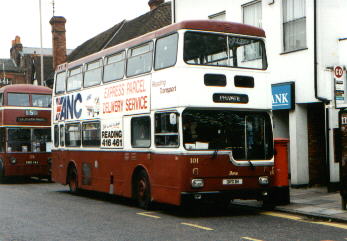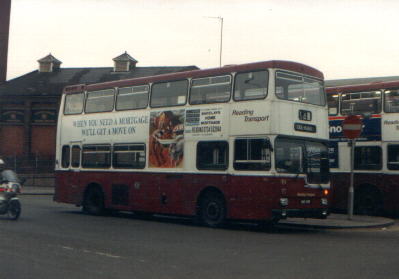The first of this type to enter service with Reading was 1 in April 1975, registered GRX 1N. It became the company's flagship vehicle and attended many rallies and exhibitions both for Reading Transport and MCW. 1 exclusively operated service 17 (specifically the 17K running card) due to its extra height relative to the rest of the fleet, and to allow comparison with Bristol VRTs that had been delivered the year before. In March 1977 it was renumbered 101 with the arrival of 102-21, and in later years it also became known as Boris. It went into preservation with that name applied to the front when the last of the Metropolitans were withdrawn in May 1992. It was the last bus in the fleet to wear maroon and white Reading Transport livery, but whilst none of the Metropolitans ever received Reading Buses livery, 101 did receive Reading Buses vinyls along with the rest of the fleet. Below is 101 at St. Mary's Butts with a preserved Reading Trolleybus not many years after its withdrawal. This photograph is from the W. Ball collection:
Structural problems meant that Boris required quite an amount of work on it to keep it in road-worthy condition, so it left the rally scene not very long after it finished service with Reading. It re-appeared in immaculate condition in July 2003 having been restored back to its original condition as 1. The Boris name was removed, and the three piece display shown above was returned back to its original two piece one. It is seen below on the British Trolleybus Society's annual tour of Reading on 4th July 2003 at the Three Tuns:
122-133 arrived in March 1978, 132 being the last Metropolitan ever built. MCW's replacement product was the Metrobus, another type purchased in quantity by Reading.
A batch of 21 second-hand Metropolitans was acquired from London Transport in October 1983, numbered 401-21 they entered service in October and November of that year. Below is 411 at Reading Station, the photograph was originally from the W. Ball collection.
In May 1986 another 14 were purchased from Tyne & Wear, although not all of these entered service. Two were numbered 302/3 and were solely used as driver trainers from the summer, and seven were numbered 422-8, gradually entering service between 1986 and 1988. The last five were used to provide parts to allow the preparation of 422-8, their remains being sold for scrap from 1987 to 1989.
Once all of the Metropolitans had entered service, at 61 vehicles Reading had one of the largest fleets of Metropolitans in the country. The type also broke the record for being the most numerous type in the Reading fleet ever, although this record was later broken by the MCW Metrobus. It was during the Metropolitan's era however, and not the Metrobuses', that Reading Transport operated an entirely double-deck fleet. This period started with the withdrawal of the last single deck Bristol RELLs in January 1983, and excluding the delivery of four Leyland Tiger coaches two months later, finished with the introduction of the first MCW Metroriders in 1988, and Optare Deltas in 1989. The end of the Metropolitans came following service cuts, deliveries of MCW Metroriders, Optare MetroRiders and Optare Deltas, and finally with second-hand MCW Metrobuses 455-69 in 1991. The last very small handful did make it into 1992, but one by one they soon disappeared.
101, 106, 416 and 426 are in preservation. 420 also spent a time in preservation (but is not preserved any more), and featured in the TV show 2.4 children!

